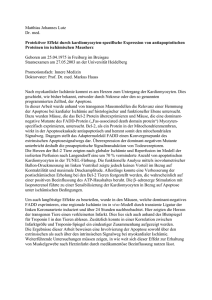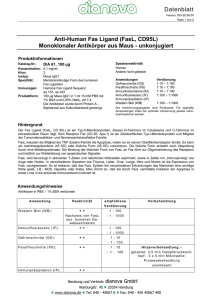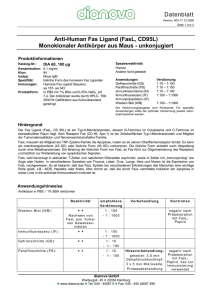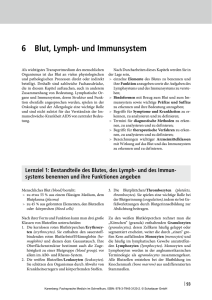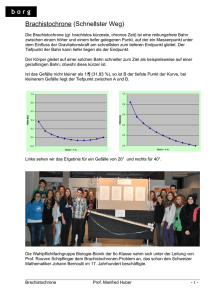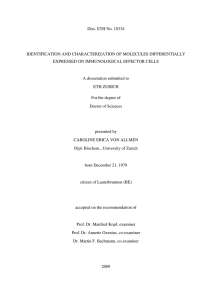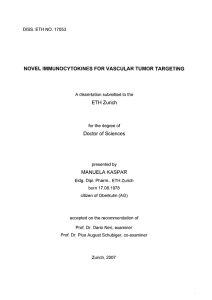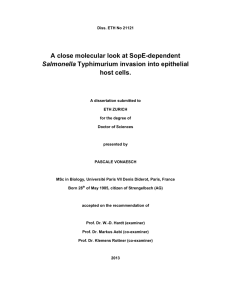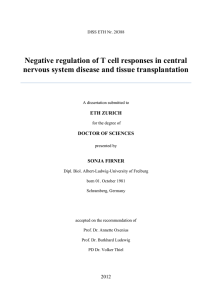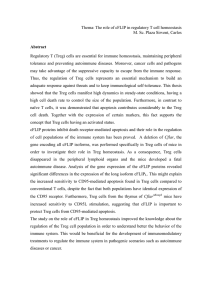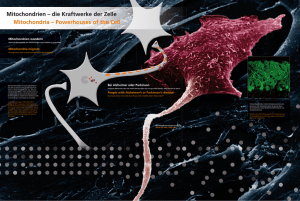SignalTransductionPathwaysin - ETH E
Werbung
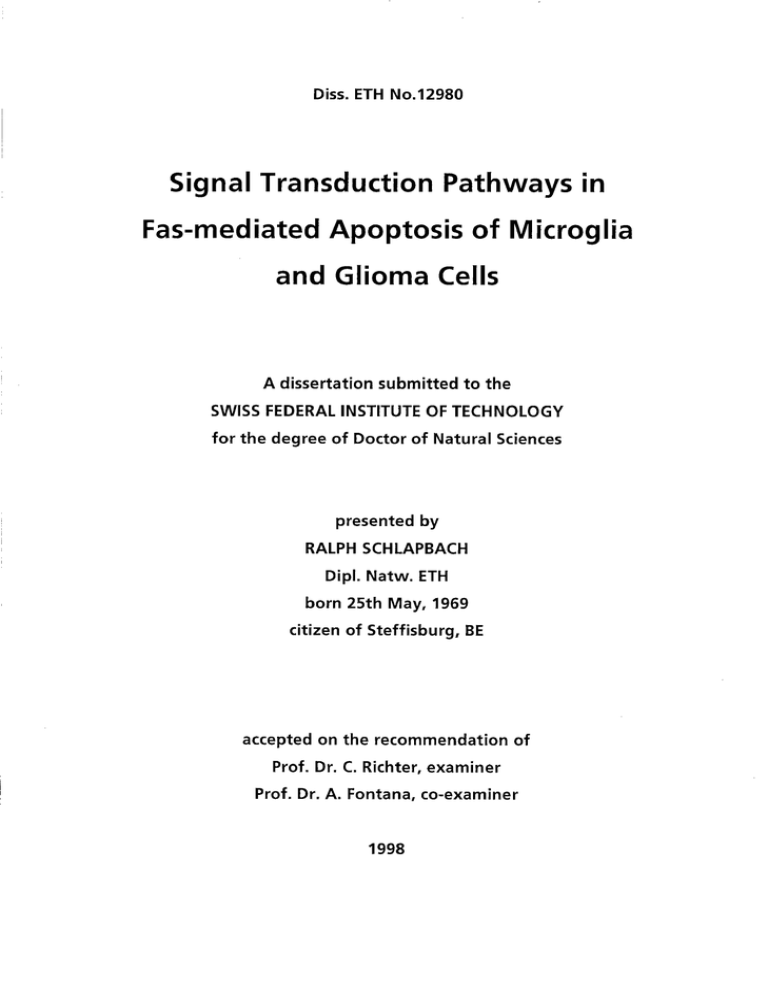
Diss. ETH No.12980 Signal TransductionPathways in Fas-mediated Apoptosis of Microglia and Glioma Cells A dissertation submitted to the SWISS FEDERAL INSTITUTEOF TECHNOLOGY for the degree of Doctor of Natural Sciences presented by RALPH SCHLAPBACH Dipl. Natw. ETH born 25th May, 1969 Citizen of Steffisburg, BE accepted on the recommendationof Prof. Dr. C. Richter, examiner Prof. Dr. A. Fontana, co-examiner 1998 1. Zusammenfassung komplexen Organismen müssen permanent einzelne Zellen gezielt eliminiert werden. Dies ist notwendig, da sich einerseits viele Gewebe ständig erneuern müssen und andererseits auf diese Weise, der Entstehung von Tumoren und der Entwicklung autoimmunologischer Reaktionen vorgebeugt werden kann. Das Sterben der Zellen folgt In den genau definierten Wegen des programmierten Zelltodes. Bei diesem auch Apoptose genannten Phänomen treten charakteristische morphologische Veränderungen auf: Die schrumpft, der Zellkern verdichtet sich und Vesikel werden von der Plasmamembran abgeschnürt. Apoptose kann sowohl durch zytotoxische Substanzen wie auch durch Interaktion mit anderen Zellen, die auf ihrer Oberfläche pro-apoptotischeSignalmoleküle tragen oder solche sezernieren, ausgelöst werden. Die Weiterleitung des Apoptose-Signals hängt von der Expression und der Funktion einer Anzahl Faktoren, wie zum Beispiel Rezeptoren an der Zelloberfläche, Adaptorproteinen, Caspasen und ihren Inhibitoren, Botenstoffen wie Ceramid, sowie zur Bcl-2 Familie gehörenden Proteinen ab. Im Rahmen dieser Dissertation wurden zwei unterschiedliche Zelltypen des Zentralnervensystems untersucht, Gliomzellen und Mikroglia. Ein ungebremstes Wachstum von Gliomzellen führt zur Entstehung maligner Tumoren, die unkontrollierte Aktivität von mikroglialen Zellen spielt wahrscheinlich eine wichtige Rolle in der Pathogenese autoimmunologischer Reaktionen im Zentralen Nervensystem. Intrazelluläre Mechanismen,welche nach der Interaktion von Fas ligand (FasL) mit dem Fas Rezeptor zur Apoptose führen wurden untersucht und mit den Signalwegen, die durch die zytotoxische Verbindung Puromycin und den Botenstoff Ceramid induziert werden, verglichen. Die Puromycin-induzierteApoptose von Gliomzellen war abhängig von der Synthese proapoptosischer Faktoren und wurde weder durch erhöhte Mengen an Bcl-2, noch durch die Antioxidantien /V-Acetyl-cystein(NAC) und Glutathion (GSH) oder durch die Inaktivierung von Caspasen beeinträchtigt. Vor dem Fas-vermittelten Zelltod dagegen wurden diese Zelle Zellen durch eine Ueberexpression von Bcl-2 teilweise und durch Hemmung Hemmung der der Caspaseaktivität vollständig geschützt. Zudem verstärkte eine Proteinexpression auf der Stufe von Transkription (Actinomycin D) und Translation (Cycloheximid) die durch anti-Fas Antikörper induzierte Apoptose. Während Gliomzellen FasL-sensitiv waren, konnten Mikroglia nur nach Vorstimulation mit proinflammatorischen Zytokinen wie TNF-a (tumor necrosis factor-a) und IFN-y (interferon-y) durch Behandlung mit FasL in Apoptose gebracht werden. Dabei scheint ein komplexer Regelmechanismus eine Rolle zu spielen: Fas wird verstärkt auf der Zelloberfläche exprimiert und die Expression anti-apoptotischer Faktoren wie Bcl-2 TNF-ct-aktivierter Mikroglia mit FasL führt und zu Bcl-xL wird reduziert. Die Stimulation einer erhöhten Caspaseaktivität. Bedeutung: NAC und GSH, Substanzen die durch ihre Wirkung auf die Atmungsketteden Redoxzustand der Zelle beeinflussen, schützten nahezu vollständig vor FasL-induzierter Apoptose. Das antiinflammatorische Zytokin TGF-ß (transforming growth factor-ß) neutralisierte die Sensibilisierung durch TNF-a und IFN-y zumindest teilweise und führte, vermutlich durch die Reduktion von Fas, die verstärkte Expression von Bcl-2 und die Verhinderung der Caspaseaktivierung, zu Resistenz gegenüber FasL. Ceramid führt zur direkten Aktivierung der Effektorcaspasen. Auf die Ceramid-induzierteApoptose von Mikroglia hatten die Mitochondrien-assoziierte Faktoren sind ebenfalls genannten pro- und antiinflammatorischen von Zytokine keinen Einfluss. Die erhöhte Expression von FLIP (FLICE inhibitory protein) nach Zytkokinstimulation könnte eine mögliche Ursache für die Hemmung der FasL-induzierten Signalkaskade oberhalb von Ceramid und am Anfangspunkt der Caspasenkaskade sein. Im Fall von TGF-ß korrelierte die Reduktion des Apoptose-Signals mit der stärksten Induktion von FLIP. Die Aufregulation von FasL auf der Zelloberfläche von TGF-ß-stimulierten Mikroglia und die Resistenz dieser Zellen selbst gegenüber FasL zeigen einen möglichen Weg auf, durch welchen sich Mikroglia der Elimination im Rahmen einer Immunreaktion entziehen könnten. 2. Summary complex organism is governed by the need for renewal and elimination of aged, supernumerary or potentially dangerous cells. In contrast to necrotic cell death following traumatic injury, cell death by apoptosis follows well tuned pathways and includes characteristic morphological features including cellular shrinkage, nuclear condensation and membrane blebbing. Apoptosis can be induced by cytostatic drugs acting at the Single cell level or by the interaction of different types of cells equipped with pro-apoptotic ligands and their respective receptors. Intracellular signaling of apoptosis may recruit multiple pathways leading to finally irreversible execution steps. Transduction of the death signal depends on the levels and funetions of a variety of factors including death receptors and adaptor proteins, caspases and their inhibitors, second messengers like ceramide, and pro- and anti-apoptotic proteins of the Bcl-2 family. In this thesis, the intracellular events which mediate apoptosis induced by Fas ligand (FasL) were investigated using glioma cells and microglia, two different types of The death of an individual cell within compared to enforced elimination of by exposure to the cytotoxic drug puromyein and by ceramide.The importance of cells of the central the cells a nervous system. The data were well-tuned elimination of these cells is illustrated by the diseases evoked by uncontrolled growth and funetion of glioma cells and microglia leading to the occurrence of malignant a tumors and autoimmune diseases in the brain, respectively. Puromycin-induced apoptosis of glioma cells was found to depend on protein synthesis and was not inhibited by increased amounts of intracellular Bcl-2 nor by addition of the antioxidants A/-acetyl-cysteine (NAC) and glutathion (GSH). Fas-mediated cell death of glioma cells was characterized by reduced killing of Bcl-2 overexpressing cells and by a complete prevention of apoptosis by caspase-inhibitors. Inhibition of protein expression through interference with transcription (with actinomyein D) and translation (with cycloheximide) enhanced Fas-mediated apoptosis induced by anti-Fas antibody. In aecordance with the pathways induced by puromyein, antioxidants did not reduce FasLinduced killing of glioma cells. Microglia were found to be killed only upon activation of the cells by the proinflammatory cytokines tumor necrosis factor-ct (TNF-a) or interferon-y (IFN-y). Activation of microglia led to increased Fas cell surface expression and to reduced levels of Bcl-2 and Bcl-xL, providing a potential explanation for the increase in suseeptibility. Furthermore, TNF-a prestimulation induced higher caspase-activities upon exposure of the cells to FasL. The importance of mitochondrial events was underlined by the high efficiency with which NAC and GSH protected from FasL-induced cell death. The anti-inflammatory cytokine transforming growth factor-ß (TGF-ß) reversed many of the effects of TNF-a and IFN-y including sensitization to FasL and led to reduced Fas cell surface expression, to upregulation of Bcl-2, and efficiently blocked the activation of caspases in resting or cytokine-activated microglia. Apoptosis-signaling induced by ceramide was independent of modulatory effects of the pro- and anti-inflammatory cytokines and was found to lead to direct activation of the downstream effector caspases. A possible explanation for the inhibition of caspase-activity in Fas-mediated apoptosis by TGF-ß may be the upregulation of the FLICE inhibitory protein (FLIP) which was found to be highest in presence of TGF-ß. Together with the TGF-ß-induced upregulation of FasL on the surface of microglia these results may outline a strategy for microglia to escape their elimination in the course of an immune response.

